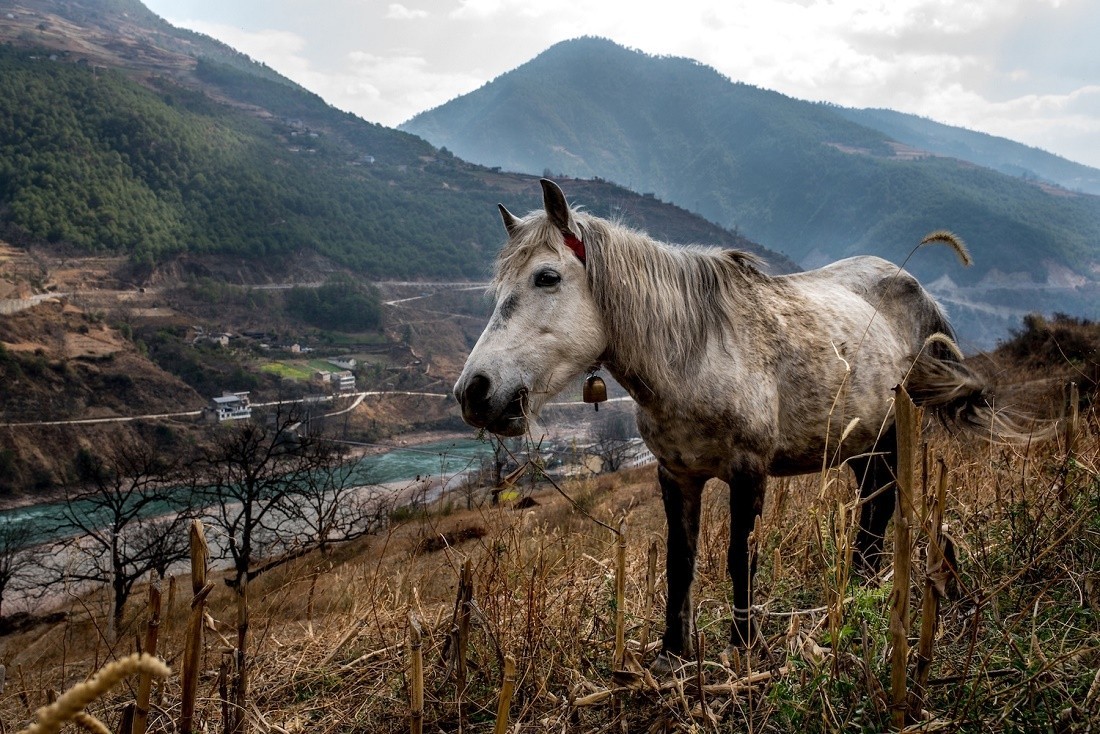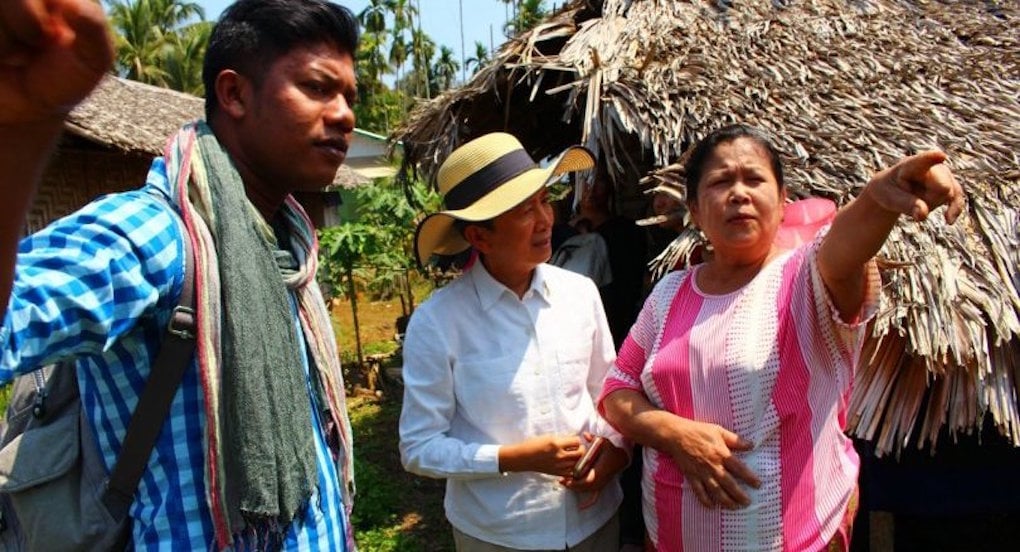YUNNAN, China — The building site of the Wunonglong hydropower dam is not ringed by barbed wire fences and security guards as one might expect. Instead, visitors to this remote northern stretch of China’s Yunnan province find themselves standing on a specially built viewing platform surrounded by a small but tidy ornamental garden and informative signage about the dam’s projected output. Though the dam is more than a year from completion, manicured bonsai trees and imported wild grasses have already been planted. When finished in 2018, more than 800 feet of roller-compacted concrete will span the Lancang and rise nearly 500 feet into the air in an incredible demonstration of China’s ability to bend nature to its purposes.
The Lancang Jiang, as the Chinese call the Mekong, can be translated into English as “the Turbulent River,” a name that makes immediate sense to anyone who has seen it. Churning torrents of whitewater rush through the bottoms of deep canyons snaking their way through China’s Yunnan province. Here, on China’s Western frontier, the wild Lancang bears little resemblance to the lazy brown expanse that will become the Mekong once it crosses the Lao border. Perhaps it should not be surprising, then, that the Chinese government has unleashed the full might of its engineering prowess on the Lancang in the form of more than 20 already built or proposed hydropower dams (pdf).
In a little more than a year, Wunonglong’s three gravity-fed turbines will convert the Lancang’s raw energy into an estimated 990 megawatts of electricity — enough, by some estimates, to power almost a million homes.Long before the Lancang builds enough force to generate electricity, it begins its life on the glaciers of the Tibetan Plateau. As the sun pierces the thin atmosphere at 5,200 meters (3.2 miles) above sea level, ice melts into trickles of water and begins an epic journey to feed Asia’s biggest rivers.
In addition to the Lancang, the Yangtze, the Ganges, and the Yellow Rivers all originate here. Ultimately, one out of five people on earth depend on the water from this part of the world for survival. The Lancang in particular, is one of the world’s most life-giving rivers, especially once it becomes known as the Mekong. Second in biodiversity only to the Amazon, and the source of sustenance for more than 60 million Southeast Asians, any disruptions in the Mekong’s hydrological or ecological balance could have disastrous human impacts.
In this part of Yunnan, the Lancang is not yet the nurturing force that it will later become, and this must be kept in mind when judging China’s attitudes towards it. In the largely ethnically Tibetan mountain village of Deqin, locals say that they have little to no regular interaction with the river. “This river is useless,” said bus driver Cili Dingzhu. “It doesn’t provide anything for us here.”
Looking down the treacherously steep canyons to the roiling water more than a vertical kilometer below, it is not difficult to see how such ambivalence has developed. The Lancang’s northern stretches are too difficult to access and too dangerous to navigate to provide much in the way of direct benefits for the hardy mountain people who populate the area.
Perhaps it is not surprising, then, that China has decided the best way to turn the Lancang into a productive resource for national development is to dam it extensively. But though the impacts of such actions might go unnoticed by Cili Dingzhu and his neighbors, further downstream in the village of Xialuoga locals tell a different story.China is now the world’s biggest financier and builder of hydropower dams, with more than 300 projects undertaken in 74 countries since the turn of the century. Southeast Asia and Africa have been the most heavily affected by this global Chinese-backed hydropower boom, but dam building is not only an export. Within China’s borders, millions of farmers and villagers have been impacted in the same way as their Southeast Asian or African counterparts.
A man repairs a section of road that was covered by landslide in the village of Xialuoga, Yunnan, China. Xialuoga sits along the banks of the Lancang (Mekong) River, but will be flooded by the completion of a nearby hydropower dam, necessitating the relocation of most residents. Photo by Luc Forsyth.
“The whole village will flood and we will have to move higher up the mountain,” said 78-year-old Chao Yunsheng who has farmed the hillsides of Xialuoga his entire life. He has lived through virtually every important moment that has defined modern China – the Communist Revolution, the invasion of Tibet, the death of Mao, and the Tiananmen Square massacre.
Throughout this tumultuous period, he has seen life in this part of Yunnan change repeatedly and drastically. The forced displacements caused by China’s widespread dam building projects are just the most recent in a long line of tumultuous times he has lived through. “When I was a boy there was not enough food to eat,” Chao remembered. “Things are much easier now.”
Far from wealthy, when Chao says things are easier he is referring to the fact that his family can generally meet their basic caloric needs. He is one of the 800 million people who have been lifted out of poverty in the fastest major economic turnaround in history, something for which the Communist government deserves credit.
But ultimately, the majority of the tangible improvements in Chao’s life are the result of the decades of backbreaking labor he put into carving out farmable land from the pine-covered valley walls that overlooked Xialuoga. Over the course of his life Chao has expanded his family’s land holdings to a respectable 20 Mu (about 3.2 acres or 8 acres). “I have a lot of land now, and I have given it to my three sons,” Chao said.
Yet, despite having survived one of the most turbulent periods in Chinese history, and after dedicating almost eight decades to working the land, nearly everything he has worked for is slated for inundation by the soon-to-be-completed 900-megawatt Tuboa dam.
“Out of the 20 mu we have, all but two will be lost,” said Chao. “We will be able to keep grazing our goats, but there will only be a small area left for farming.” Considering that his crops account for roughly half the family’s income, the loss of 90 percent of his cultivatable land would be a serious financial blow.
An elderly woman tends to her vegetable plot in the village of Xialuoga, Yunnan, China. Photo by Luc Forsyth.
It is not only farmers who will be affected by such developments. Across the Lancang in the community of Baijixunxiang, urban residents face the same uncertain future as Chao. “I don’t know what’s happening,” said 75-year-old shop owner Li Ruqi. “This dam has been talked about for a long time, but there have been many delays and I have no idea when it will be finished. But if the government says I have to move, then I will have to move.” Selling cigarettes and other basic sundries like instant coffee and soap, his business overlooks the river which, he said, plays little practical role in the everyday lives of Baijixunxiang residents.
Despite the fact that people such as Li Ruqi and Chao Yunsheng stand to lose nearly everything when dams such as Tuboa are completed, they exhibit a distinct lack of animosity towards the national government, at least when speaking to a foreign journalist. “The new president (Xi Jinping) is very good!” Chao said emphatically of the current General Secretary of the Communist Party. “He gave out bags of rice to people with disabilities, which is very nice and the old presidents did not do.”Li Ruqi expressed even more faith in the national government saying, “I have no concerns for the future of my six children. The government will look after them.” Yet when conversation turned to local officials, Chao’s tone turned bitter: “The president is good … but the lower ranking officials are corrupt. No matter what our compensation is, it will most likely be pocketed bit by bit by the corrupt officials.
“This certainty over corruption exists despite the fact that no one yet seems to know how they will be compensated for the loss of property — though Chao Yunsheng said he has heard rumors they will be paid around 1200 Yuan ($185 USD) per ancestral grave lost — or even when they will be required to abandon their land. What is certain, however, is that once a dam is built the ecology of the surrounding area is changed forever. For such an example, one need look roughly 1,000 kilometers (660 miles) to the South, to the town of Jinglin River Bridge.
“They only started fishing here three years ago,” said 52-year-old farmer-turned-hotelier Zhang Yun. Jinglin River Bridge is currently home to a fishing bonanza that owes its entire existence to dams. “Before the (Dachaoshan) dam was built the river moved too fast. 20 years ago, if you jumped in here the currents would carry you away. It has changed a lot,” Zhang said.
As recently as three years ago there was no money being made from these waters, says fisherman Su Youdong. But after the Dachaoshan Dam was completed upstream of the town, the Lancang’s speed was drastically slowed; locals with small steel boats were able to ply sections of the river that would have once been suicidal for anyone but whitewater professionals. Now, former farmers like Su are abandoning their fields to cash in on the profitable boon. They say it is possible to make up to $100 on a good day of fishing – a small fortune in a country where the average rural income is still less than $2000 per year.
Although the nascent fishing industry in Jinglin River Bridge is barely more than a few years old, there are signs that it is already nearing exhaustion.
Fishermen stand in their boat on a tributary of the Lancang (Mekong) River in Jinglin, Yunan, China. Photo by Luc Forsyth.
“I’ve got ten nets in the river, and I still catch plenty of fish,” says Su Youdong. “But the rare and expensive species are gone — now I catch mainly common species, like tilapia and carp.” If Su is not overly concerned about the end of the short-lived fishing industry, it is because when it runs dry he will return to farming, his former source of income. Lancang River fishing has never been a historical source of livelihood in China, and the fact that it exists at all in this small riparian village is an anomaly.
It is not Chinese villagers, however, whose lives are tied to the ecology of this river, but those living far to the South in the lower Mekong basin. According to environmental watchdog International Rivers, the changes in the river’s flow caused by Chinese dams have altered water levels by as much as 49 percent in the dry season, and the effects can be felt as far away as Cambodia. It is here, in countries such as Laos and Cambodia and not in China, where the real consequences of Lancang River damming will be felt most acutely. Herein lies the main challenge in creating a sustainable future for the Mekong, a river that crosses multiple international borders and several distinct political systems.
Each nation lives with a different economic and environmental reality, and what might be only a turbulent river for the Chinese, fit only to be converted into electricity, is the direct source of sustenance for tens of millions of Southeast Asians. The real impacts of China’s widespread damming of the Lancang may not be felt until thousands of miles downriver, where those who depend directly on the Mekong for survival find themselves living along a river that can no longer support them.
Travel expenses for this project were supported by Lien AID, a Singapore-based non-profit focused on providing clean water solutions across Asia. Lien AID did not provide payment to the reporters beyond the hard costs associated with travel, and did not attempt to interfere with the objectivity of the reporting.
Main Image: A horse grazes on the mountain sides overlooking the village of Xialuoga, Yunnan, China. Photo by Luc Forsyth.








